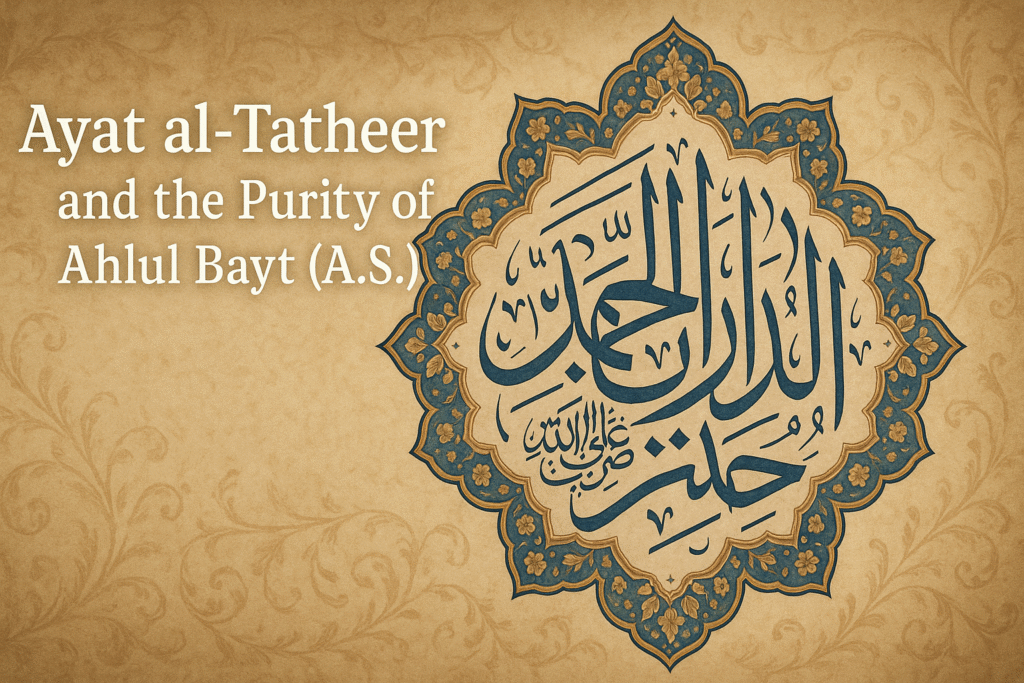Introduction
In the heart of the Holy Quran lies a verse that has sparked centuries of reflection, reverence, and scholarly discourse among Muslims: Ayat al-Tatheer. Found in Surah al-Ahzab (33:33), this verse speaks directly to the concept of divine purification—specifically of the Prophet Muhammad’s (PBUH) household, the Ahlul Bayt (A.S.). It has become a cornerstone for understanding their elevated spiritual status and foundational role in Islam, particularly within the Shia tradition.
This article explores the context, meaning, and theological implications of Ayat al-Tatheer, and how it affirms the purity and authority of Ahlul Bayt (A.S.), shaping both spiritual devotion and doctrinal clarity across generations.
Focus Keywords: Ayat al-Tatheer, Ahlul Bayt purity, Quran and Ahlul Bayt, 33:33 tafsir
Table of Contents
- Historical Context of Ayat al-Tatheer
- Meaning and Language of the Verse
- Who Are the Ahlul Bayt (A.S.)?
- Tafsir and Sunni-Shia Perspectives
- Spiritual and Doctrinal Significance
- Modern Reflections and Relevance
- Conclusion
Historical Context of Ayat al-Tatheer
Ayat al-Tatheer appears in Surah al-Ahzab, verse 33:
“Indeed, Allah desires to repel all impurity from you, O People of the House, and purify you with a thorough purification.” (Quran 33:33)
This part of the verse is known as Ayat al-Tatheer (The Verse of Purification). Though it is embedded within a passage addressing the wives of the Prophet (PBUH), both Sunni and Shia sources agree that this specific portion shifts its grammatical construction and audience to refer to a different group: the Ahlul Bayt.
The event of the Hadith al-Kisa (Tradition of the Cloak) is universally cited to explain this transition, in which the Prophet (PBUH) gathered Imam Ali (A.S.), Sayyeda Fatima (S.A.), Imam Hasan (A.S.), and Imam Hussain (A.S.) under his cloak and declared them his Ahlul Bayt.
Meaning and Language of the Verse
The Arabic phrase “innama yuridu Allah li-yudhhiba ‘ankum al-rijsa ahl al-bayt wa yutahhirakum tatheera” is unique in its use of exclusive language and a double emphasis on purification.
- “Innama”: Exclusivity, indicating a clear and specific divine will
- “Al-rijs”: All forms of impurity—physical, moral, and spiritual
- “Tatheera”: Reinforces the thoroughness of this purification
The shift from feminine to masculine grammatical structure in this verse, right after speaking to the Prophet’s wives, is critical. Arabic grammar aligns gender with audience, and here, the masculine plural indicates a broader and different group.
Who Are the Ahlul Bayt (A.S.)?
According to both Sunni and Shia hadith traditions, particularly the Sahih collections and the Musnad of Ahmad ibn Hanbal, the core members of the Ahlul Bayt (A.S.) include:
- Prophet Muhammad (PBUH)
- Imam Ali ibn Abi Talib (A.S.)
- Sayyeda Fatima al-Zahra (S.A.)
- Imam Hasan (A.S.)
- Imam Hussain (A.S.)
This is validated in the famous Hadith al-Kisa, narrated by multiple companions, including Umm Salama (RA), who asked to join under the cloak and was gently told she was virtuous but not among “them.”
Shia Islam extends this concept of Ahlul Bayt to include the Twelve Imams, spiritual and temporal successors of the Prophet (PBUH) through Imam Ali (A.S.) and Sayyeda Fatima (S.A.).
Tafsir and Sunni-Shia Perspectives
Shia Tafsir
In Shia tafsir (e.g., Tafsir al-Mizan by Allama Tabatabai), Ayat al-Tatheer is a doctrinal proof of the infallibility (‘Ismah) of Ahlul Bayt. Divine purification implies protection from sin and error, establishing them as the most trustworthy sources of religious knowledge.
Sunni Tafsir
Sunni scholars like Imam Muslim, Al-Tirmidhi, and Fakhr al-Din al-Razi also affirm the Hadith al-Kisa. While Sunni tafsir may include the Prophet’s wives in the broader Ahlul Bayt, many agree that the specific purification mentioned applies uniquely to those under the cloak.
Despite these nuances, both traditions recognize the unmatched piety, status, and spiritual authority of the Prophet’s family.
Spiritual and Doctrinal Significance
Ayat al-Tatheer forms a key component of Shia theology and spiritual practice:
- Infallibility of the Imams (A.S.): This verse is used to support the belief that the Imams are divinely guided and protected from sin
- Foundation for Wilayah (spiritual authority): Establishes their role as the legitimate inheritors of the Prophet’s mission
- Daily devotion: Shia Muslims recite this verse in Ziyarah, Duas, and Majalis to reaffirm their spiritual bond with the purified family
In Sunni circles, it serves as a reminder of the Prophet’s deep love for his family and the obligation to respect and honor them.
Modern Reflections and Relevance
Today, Ayat al-Tatheer continues to be a source of unity and contemplation. As sectarian tensions rise globally, this verse offers a shared reverence for the household of the Prophet—a point of spiritual convergence.
- For Shia Muslims, it reaffirms the unique station of the Imams and fuels devotion and ethical behavior
- For Sunni Muslims, it serves as a call to honor and remember the Prophet’s family with sincerity and love
In interfaith and intrafaith dialogues, Ayat al-Tatheer is often referenced as a common ground for understanding the early Islamic community and its moral anchors.
Conclusion
Ayat al-Tatheer is more than a verse—it’s a divine testimony to the purity, responsibility, and centrality of the Ahlul Bayt (A.S.) in Islamic life. It invites Muslims to reflect on the values of truth, piety, and justice embodied by this blessed family.
In a time when the Muslim Ummah seeks guidance and unity, returning to the example of the purified ones under the cloak can rekindle faith, love, and direction.
Also read:

